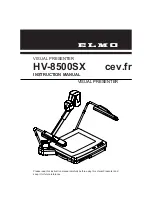
mirror, the 6-edges viewing mirror is used in the
optical path twice. First, the light rays entering
the camera from the taking lens are reflected
onto the Fresnel screen by the viewing mirror.
Secondly, the operator views the image on the
screen with light reflecting off the viewing mirror
(Figure 2-1). (The viewing mirror is located on
the underside of the mirror cover assembly.)
Figure 2-4 Wafer lens assembly
Figure 2-5 ECM - Electronic Control Module
The viewfinder optics consist of an eye lens, a
concave mirror and a wafer lens (Figure 2-4). As
in all simple optical system, a certain amount of
distortion is inherent in this design. A small wafer
lens is introduced into the viewfinder optical path
to limit to angle of acceptance and, thus, reduce
distortion. The size of the lens opening is large
enough to provide acceptable viewing brilliance
and, at the same time, small enough to be easily
closed when the camera is in the exposure mode.
(On earlier models a rectangular mask called a
stigmatic pupil takes the place of the wafer lens.
The flare baffle (Figure 2-2) is a spring-loaded
plate which springs up when the Fresnel screen
moves into the picture-taking mode. In this state,
light is prevented from passing through the lens
directly onto the film without first being reflected
off the taking mirror. This prevents «hotspots»
from appearing on the finished picture. When
the Fresnel carrier is in the lowered position, the
flare baffle is held down, out of the optical path.
The SX-70 is unique, both in its principles of
operation and its functional design. It can be
considered as aan electronically controlled
mechanical device. An electronic control module
(substrate or ECM) contains all of the electronic
components with the exception of the motor
control (MCC) integrated circuit and the flash fire
assembly (FFA). Because the ECM is located
inside the shutteur housing, it becomes identified
as part of the shutter (Figure 2-5). It should
be noted that all of the camera automation is
controlled by the integrated circuits in the ECM.
Ignoring the shutter functions momentarily, when
the operators presses the exposure button, the
Fresnel carrier swings away from the film plane
and comes to rest in front of the viewing mirror.
During the moment of the Fresnel carrier (and
until it returns to its initial viewing position), a
flexible light stop closes a path between the
viewfinder and the inner camera to prevent light
trough the eye lens from reaching the film. The
movement of the spring-driven Fresnel carrier is
accomplished by the motor-driven gear train. The
details of the automated action are described
in the discussion of the electro / mechanical
assemblies.
2. Viewfinder
4. Flare baffle
1. General
Two first surface mirrors are used in the SX-70
optical system. When a picture is being taken,
the Fresnel carrier is raised. This places the
4-edges taking mirror into the optical path and
light is reflected onto the film plane. (The taking
mirror is mounted on the Fresnel carrier on the
side opposite the Fresnel screen.) The second
3. Mirrors
E. CAMERA ELCTRONICS
















































